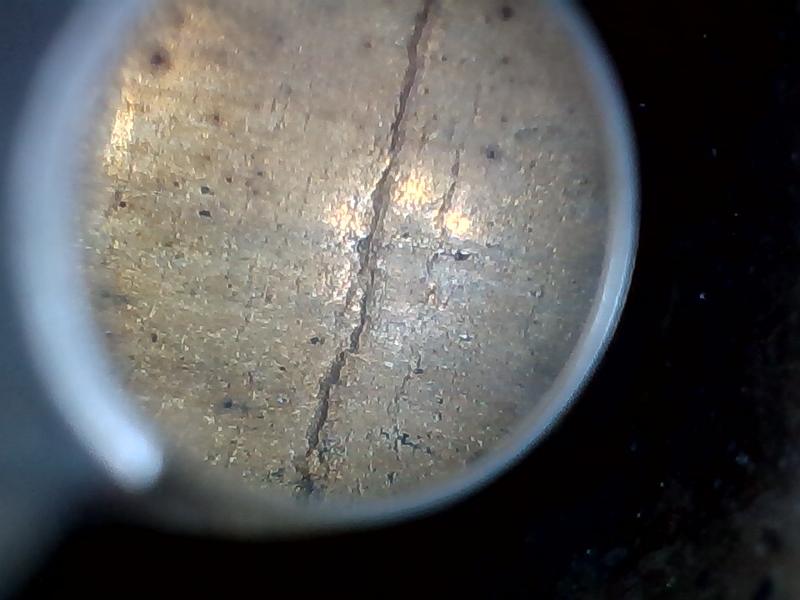Expand necks up a cal, then set false shoulder as usual.I can see that with different calibers, but the load I was talking about was a 22-250 to a 22-250 Ackley and other calibers I made Ackley's out of. If the same caliber, I don't see how you can make a false shoulder.
You are using an out of date browser. It may not display this or other websites correctly.
You should upgrade or use an alternative browser.
You should upgrade or use an alternative browser.
Brass Case Head Separation after 6 firings
- Thread starter nksmfamjp
- Start date
 Help Support Long Range Hunting Forum
Help Support Long Range Hunting Forum
QuietTexan
Well-Known Member
It's not nearly as drastic a difference when doing an Ackley versus necking up to a new caliber, we're talking a couple of thous here. Visually it doesn't look like much, it's very similar to when you set a bushing to not size the full neck. This article has pictures down at the bottom of how/why it works when not changing calibers using a Hornady comparator:I can see that with different calibers, but the load I was talking about was a 22-250 to a 22-250 Ackley and other calibers I made Ackley's out of. If the same caliber, I don't see how you can make a false shoulder.
260 Ackley Case Forming
6mmBR.com is the best guide for 6mm BR Benchrest precision shooting, complete with 6BR FAQ, Reloading Data, Shooter Message Boards, Reader Polls, and Photo Gallery. Match event calendar and rifle competition accuracy training tips. Equipment reviews (.243 bullets, 30BR cartridge, 6mm Norma...
www.6mmbr.com
You're moving the crush from the shoulder to the false necked up shoulder at the front of the chamber to hold the case against the bolt face. It doesn't matter if you're sizing back to a larger caliber after using a much larger mandrel, or the original caliber using a smaller mandrel.
Last edited:
shinbone
Well-Known Member
Muddyboots
Well-Known Member
Finally! A really good use for a Teslong!
LongBomber
Well-Known Member
If going with a false shoulder I found that it is best to set it with 7-10 thou of crush. A very stiff bolt close. Done that way I have found very little case stretch at the head and longer case life.Gotcha. That is my favorite part about the M70 action. Easy to remove the firing pin!
Actually, I think I had a couple issues. First I used 280AI brass. It is just too strong of a shape. It think it pulled instead of just blowing out. Additionally, I don't think I annealed after creating the false shoulder.
I set the die to just barely close the bolt?
nksmfamjp
Well-Known Member
- Joined
- Jan 5, 2004
- Messages
- 3,201
I didn't measure, but using a hard crush.If going with a false shoulder I found that it is best to set it with 7-10 thou of crush. A very stiff bolt close. Done that way I have found very little case stretch at the head and longer case life.
Be sure to keep lots of grease on your lugs. Don't want them galling. I too use false shoulder method. It's the best!I didn't measure, but using a hard crush.
-----------
Follow on Instagram
Subscribe on YouTube
Amazon Affiliate

dennisinaz
Well-Known Member
You're completely wrong in your assumption that the brass shortens. Often it stays the same length and the 'thins out' to accommodate the extra diameter. This is what causes case head separationAnytime you blow a case out to a larger diameter, you lose length. The reason is because you are increasing the circumference. A larger circumference requires more metal. So to get that larger diameter, the extra metal needs to come from somewhere. More metal just doesn't magically appear, so the length shortens.
πD (3.1416 x Diameter) will give you the circumference. Just for math fun, take the starting diameter of the body/shoulder junction on both cartridges and figure the difference. Then do the 2 neck diameters. That will tell you how much difference in length you are changing the circumference.....next math class is "pies are square" which gives the area increase.
Rflshootr
Well-Known Member
It's not an assumption, it's a fact. It will only lengthen if you fire-form it incorrectly and let it stretch at the base. Then it lengthens. If you know what you are doing and not assume you know, and fire-form properly, it shortens. Read post #51. There is a perfect example. Now tell that man that his brass is the same length or longer.You're completely wrong in your assumption that the brass shortens. Often it stays the same length and the 'thins out' to accommodate the extra diameter. This is what causes case head separation
Last edited:
QuietTexan
Well-Known Member
Absolutes don't tend to work out well, gotta be careful throwing them around because some of us have practical experience with the exact opposite of what you're saying.You're completely wrong in your assumption that the brass shortens.
Cases can and will shorten when fireforming to a new chamber with less body taper. It's dependent on a number of factors, but sure enough I have a couple of chambers where you put in a loaded round, shoot it, and the case comes out shorter. I know this for a fact because I trim to a specific spec after resizing for fireforming, measure the cases get shorter after the first firing, then go back through and uniform the cases even shorter after they stabilize in their new form.
A big part of having a case get shorter at the neck instead of thinning out at the web is how the case and the rifle are set up for fireforming. A false shoulder is one way, hard jam of the bullet to the lands is another. Something as mundane as removing the ejector can change what part of the case stretches. Jamming a bullet with light neck tension isn't enough sometimes because the firing pin spring can jam the case forward. Takes some real thought to get the correct outcomes when forming.
Now something like a 300 WM you can shoot it and have the web stretch like you described very easily. This is the reason Peterson "long" brass exists - to give the handloader more case length to work with on the initial firing to avoid exactly what you describe of the case stretching instead of the shoulders blowing forward. The brass makes it possible to load new 300 WM brass more like how modern cases are loaded for the first firing and not having to even consider fireforming the case to get the shoulders all the way forward to where they can be bumped.
Then there's also a lot of thought that goes into processes for trimming cases if they do grow. My opinions fall generally along the lines that trimming too early in the case forming process (and/or coupling early trimming with excessively resizing cases) can induce the problem of inconsistent case lengths on subsequent firings. Also not inspecting cases before trimming to see how/why they're growing and if it's happening consistently/ uniformly destroys important information with the cutter.
I had a case head separation in 308 with federal brass after about 5 firings with heavy 200 gr bullets. Afterward I checked the rest of the brass and many were showing signs. I think heavy for caliber bullets cause higher pressures at least in 308.
QuietTexan
Well-Known Member
I wouldn't say heavy bullets cause higher pressure, because pressure is a powder and timing issue. Depending on your seating depth you could be increasing pressure because the bullet is taking up powder space inside the case. Or if the bullet has a long bearing surface you could be causing a higher chamber pressure spike because it has more resistance to getting started moving. Those issues can be mitigated by changing powders and seating depths though.I think heavy for caliber bullets cause higher pressures at least in 308.
MagnumManiac
Well-Known Member
- Joined
- Feb 25, 2008
- Messages
- 5,596
Pressure has nothing to do with case head separation.I had a case head separation in 308 with federal brass after about 5 firings with heavy 200 gr bullets. Afterward I checked the rest of the brass and many were showing signs. I think heavy for caliber bullets cause higher pressures at least in 308.
There is ONE, and ONLY ONE cause of case head separation…EXCESSIVE HEADSPACE.
There are TWO ways to get excessive headspace; one is a chamber out of spec with excessive headspace as cut; or, two, excessive headspace INDUCED by the HANDLOADER.
If you bump anymore than necessary, say .001" from chamber including spring back, then after 5 firings, the case is gonna grow that amount causing the thinning. PERIOD.
QuietTexan,
Webs do not stretch in belted mags from firing them the first time… it can't stretch because the belt IS the headspace control, the shoulder blows out, the neck shortens and the case fills the chamber.
It is INDUCED after the fact of the first firing by sizing the shoulder back too far. It should NOT be sized for 3 firings, just neck sizing is enough.
All these MYTHS are still bandied about by those that DO NOT have the means of measuring before and after.
Cheers.
Last edited:
QuietTexan
Well-Known Member
Any case can stretch on the first firing? The distance between the bolt face and the end of the belt in the chamber isn't controlled for in every bolt/action combination, just like headspace to the shoulder isn't consistent in certain bolt designs. When fireforming if you don't pull the ejector and the firing pin overcomes whatever jam method was used the shoulder's don't blow forward as far on the first firing. I can measure that with a headspace comparator by running a false shoulder case, a jammed case, and a poorly jammed case back to back to back. If the shoulders don't move as far forward on the first firing, then it takes a second fireforming load to get it right or it's the same as if you excessively resized a case. Maybe that's where we're different - the second firing is when the problem is induced, not necessarily by resizing but by not letting the case fully form?QuietTexan,
Webs do not stretch in belted mags from firing them the first time… it can't stretch because the belt IS the headspace control, the shoulder blows out, the neck shortens and the case fills the chamber.
It is INDUCED after the fact of the first firing by sizing the shoulder back too far. It should NOT be sized for 3 firings, just neck sizing is enough.
All these MYTHS are still bandied about by those that DO NOT have the means of measuring before and after.
Cheers.
A belted mag can't be jammed as far forward , but try forming shoulders using a bolt head where you can change out the bolt face like a Savage and consistency can be hard to get. This is partly why I use false shoulders, because my Savage target action has enough slop in the bolt face that I couldn't get a jam method to be consistent enough. I wasn't going to waste barrel life running multiple rounds of fireforming loads, so it now has a standard SAAMI chambered barrel on it that runs a weak 20* shoulder because IMO the action isn't tight enough to handle a better chamber. Definitely not the 30-338 LM Improved that I was hoping for, I got a Defiance target action to handle that amount of case shoulder movement.
Last edited:
